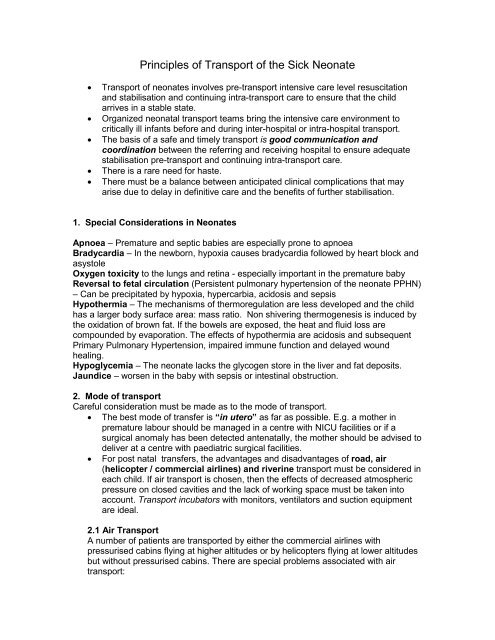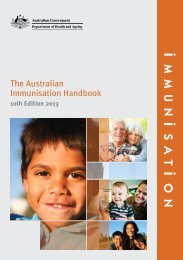Contents Chapter Topic Page Neonatology Respiratory Cardiology
Contents Chapter Topic Page Neonatology Respiratory Cardiology
Contents Chapter Topic Page Neonatology Respiratory Cardiology
You also want an ePaper? Increase the reach of your titles
YUMPU automatically turns print PDFs into web optimized ePapers that Google loves.
Principles of Transport of the Sick Neonate<br />
• Transport of neonates involves pre-transport intensive care level resuscitation<br />
and stabilisation and continuing intra-transport care to ensure that the child<br />
arrives in a stable state.<br />
• Organized neonatal transport teams bring the intensive care environment to<br />
critically ill infants before and during inter-hospital or intra-hospital transport.<br />
• The basis of a safe and timely transport is good communication and<br />
coordination between the referring and receiving hospital to ensure adequate<br />
stabilisation pre-transport and continuing intra-transport care.<br />
• There is a rare need for haste.<br />
• There must be a balance between anticipated clinical complications that may<br />
arise due to delay in definitive care and the benefits of further stabilisation.<br />
1. Special Considerations in Neonates<br />
Apnoea – Premature and septic babies are especially prone to apnoea<br />
Bradycardia – In the newborn, hypoxia causes bradycardia followed by heart block and<br />
asystole<br />
Oxygen toxicity to the lungs and retina - especially important in the premature baby<br />
Reversal to fetal circulation (Persistent pulmonary hypertension of the neonate PPHN)<br />
– Can be precipitated by hypoxia, hypercarbia, acidosis and sepsis<br />
Hypothermia – The mechanisms of thermoregulation are less developed and the child<br />
has a larger body surface area: mass ratio. Non shivering thermogenesis is induced by<br />
the oxidation of brown fat. If the bowels are exposed, the heat and fluid loss are<br />
compounded by evaporation. The effects of hypothermia are acidosis and subsequent<br />
Primary Pulmonary Hypertension, impaired immune function and delayed wound<br />
healing.<br />
Hypoglycemia – The neonate lacks the glycogen store in the liver and fat deposits.<br />
Jaundice – worsen in the baby with sepsis or intestinal obstruction.<br />
2. Mode of transport<br />
Careful consideration must be made as to the mode of transport.<br />
• The best mode of transfer is “in utero” as far as possible. E.g. a mother in<br />
premature labour should be managed in a centre with NICU facilities or if a<br />
surgical anomaly has been detected antenatally, the mother should be advised to<br />
deliver at a centre with paediatric surgical facilities.<br />
• For post natal transfers, the advantages and disadvantages of road, air<br />
(helicopter / commercial airlines) and riverine transport must be considered in<br />
each child. If air transport is chosen, then the effects of decreased atmospheric<br />
pressure on closed cavities and the lack of working space must be taken into<br />
account. Transport incubators with monitors, ventilators and suction equipment<br />
are ideal.<br />
2.1 Air Transport<br />
A number of patients are transported by either the commercial airlines with<br />
pressurised cabins flying at higher altitudes or by helicopters flying at lower altitudes<br />
but without pressurised cabins. There are special problems associated with air<br />
transport:
















